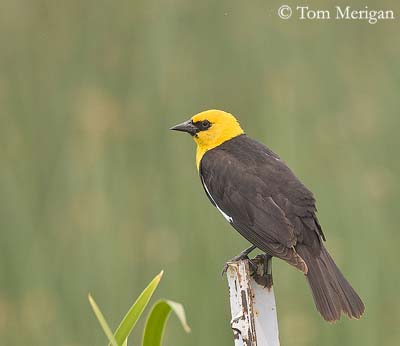
Yellow-headed Blackbird
Xanthocephalus xanthocephalus
Passeriforme Order – Icteridae Family
BIOMETRICS:
Length: 24 cm
Wingspan: 38 cm
Weight: 65 g
LONGIVITY: up to 10 years

DESCRIPTION:
Yellow-headed Blackbird has bright yellow head, neck and breast, and white wing patch (on primary coverts and outer greater coverts). It has black lores and chin. Its body is black.
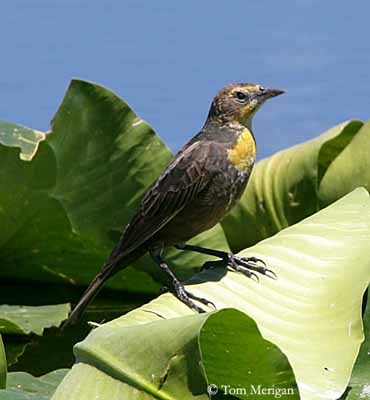
The adult female is smaller and duller, more greyish-brown overall, yellow distinctly duller and restricted supercillium, throat and breast, whitish streaking on lower breast, and no white wing patch.
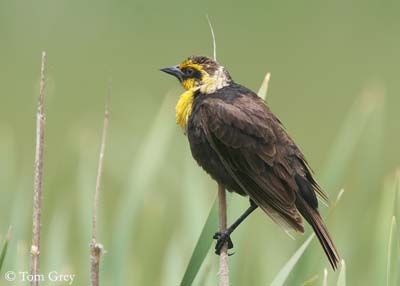
Juveniles are similar in appearance to the adult female.
Male and female have sharply pointed black bill, and blackish legs and feet.
Altricial nestlings are downy, with buff, sparse down on head and back.
VOICE: SOUNDS BY XENO-CANTO
Yellow-headed Blackbird’s song begins with a harsh, rasping note, ends with a long, descending buzz. Call note is a “croak”. The male sings during the courtship, a short, choked notes song, very unpleasant for human listeners. This bird has a wide variety of vocalizations: first, an “accenting song” very musical and then, a “buzzing song”, more nasal. Female sings too, but her song is an unmusical chatter.
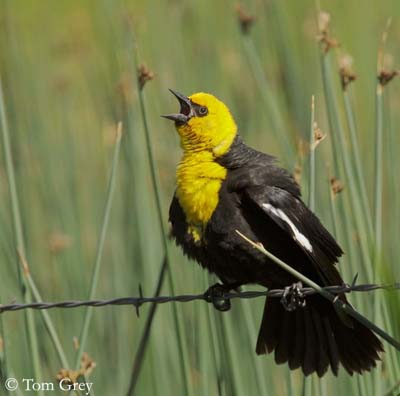
HABITAT:
Yellow-headed Blackbird inhabits in freshwater marshes and damp fields during the summer. During migration and winter months, is found in open, cultivated lands, fields and pastures.
RANGE:
During the summer, it migrates north to the west-central parts of Canada and United States. During the winter, it can be found from California to Texas, as well as in Mexico, and casually in Costa Rica.
BEHAVIOUR:
Yellow-headed Blackbird feeds by gleaning insects and seeds from plants and from the ground, and by hawking insects in the air. To forage, it pushes its bill into the ground or a food, and forces with open bill. It can be seen foraging in fields, meadows, ranches, agricultural areas and farms.
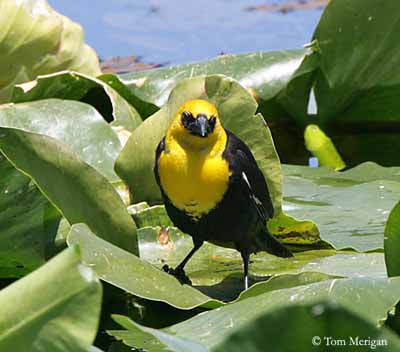
It is a strongly territorial bird during the breeding season. It nests in marshes above water. The male stakes out its claim in a habitat of reeds over open water.
Females arrived a few days later and are pursued by the males, with spread tail and half-open wings, and singing. It is a sound more like a saw grating metal, than a soft song!
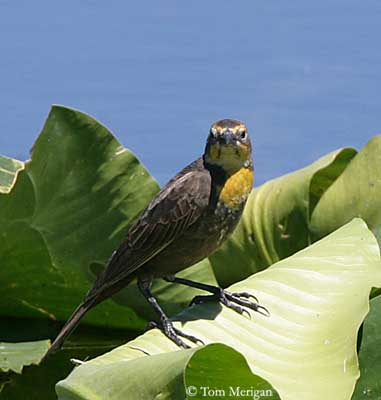
The Yellow-headed Blackbird is a polygamous breeder, and it may be able to secure up to as many as six mates, depending of the quality of its territory. Courtship and territorial displays include boundary disputes. The head is turned to the side instead of upwards.
Yellow-headed Blackbird is gregarious, often travelling and roosting in flocks. During fall migration, males often form flocks that are separate from the females and young. In winter, they form enormous flocks with others species.
FLIGHT:
Yellow-headed Blackbird shows its white wing patches in flight.
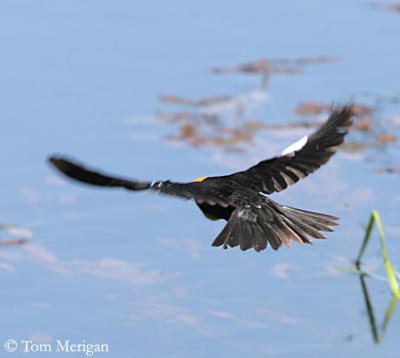
REPRODUCTION:
Yellow-headed Blackbird female builds a bulky, woven nest of wet vegetation, in the reeds over the water. As the nest’s materials dry, it shrinks, tightening its support on the emergent vegetation where is attached.
The female needs 2 to 4 days to build the nest. It may be suspended almost up to on metre above the water.
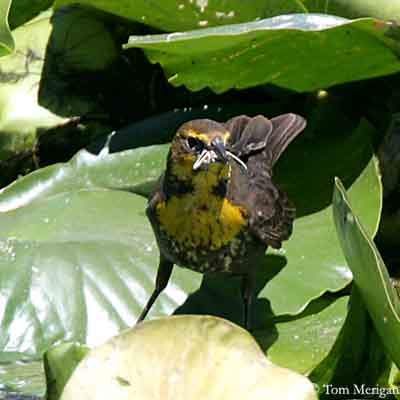
The female lays 3 to 5 greenish-white eggs with dark marks. Incubation lasts about 11 to 13 days by the female. During the time in nest, both parents feed the young. They feed the chicks, at least partly, by regurgitation for the first four days. Nestlings are fed exclusively on insects. The young fledge within 9 to 12 days of hatching.
Yellow-headed Blackbird raises one (possibly two) broods each summer.

DIET:
Insects are their favourite food, but Yellow-headed Blackbird also forages on the ground, searching seeds, spiders and grass. It is a specialist on aquatic preys, in particular insects, dragonflies, damselflies and others.
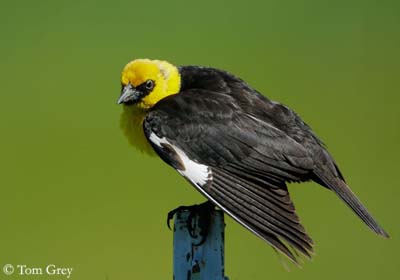
PROTECTION / THREATS / STATUS:
Yellow-headed Blackbird feeds on newly planted seed in agricultural fields, and is responsible for losses crops. But, as an insect eater, it may benefit humans by eating insects such as grasshoppers.
This bird has some predators, including gulls, coots and rails, snakes, minks, foxes, raccoons, mice and skunks. Adult are preyed upon by owls, and the Northern Harrier (Circus cyaneus).
Populations are widespread, abundant and secure.
Fr: Carouge à tête jaune
All : Brillenstärling
Esp: Turpial de Cabeza Amarilla
Ital: Ittero testagialla
Nd: Geelkoptroepiaal
Russe: Желтоголовый трупиал
Sd: Gulhuvad trupial
Photographs by Tom merigan
His website : Tom Merigan’s Photo Galleries
Photographs by Tom Grey
His website: Tom Grey's Bird Pictures
Text by Nicole Bouglouan
Sources:
FIELD GUIDE TO THE BIRDS OF NORTH AMERICA by National Geographic Society - National Geographic Society - ISBN: 0792274512
NEW WORLD BLACKBIRDS – THE ICTERIDS by Alvaro Jaramillo and Peter Burke – Helm - ISBN : 0713643331
A GUIDE TO THE BIRDS OF MEXICO AND NORTHERN CENTRAL AMERICA by Steve N. G. Howell, Sophie Webb - Oxford University Press - ISBN: 0198540124
BIRDS OF THE GREAT BASIN – by Fred A. Ryser - Univ of Nevada Pr -ISBN: 0874170796
All About Birds (Cornell Lab of Ornithology)
Animal Diversity Web (University of Michigan Museum of Zoology)
Bird Web (Seattle Audubon Society)
Wikipedia (Wikipedia, The Free Encyclopedia)